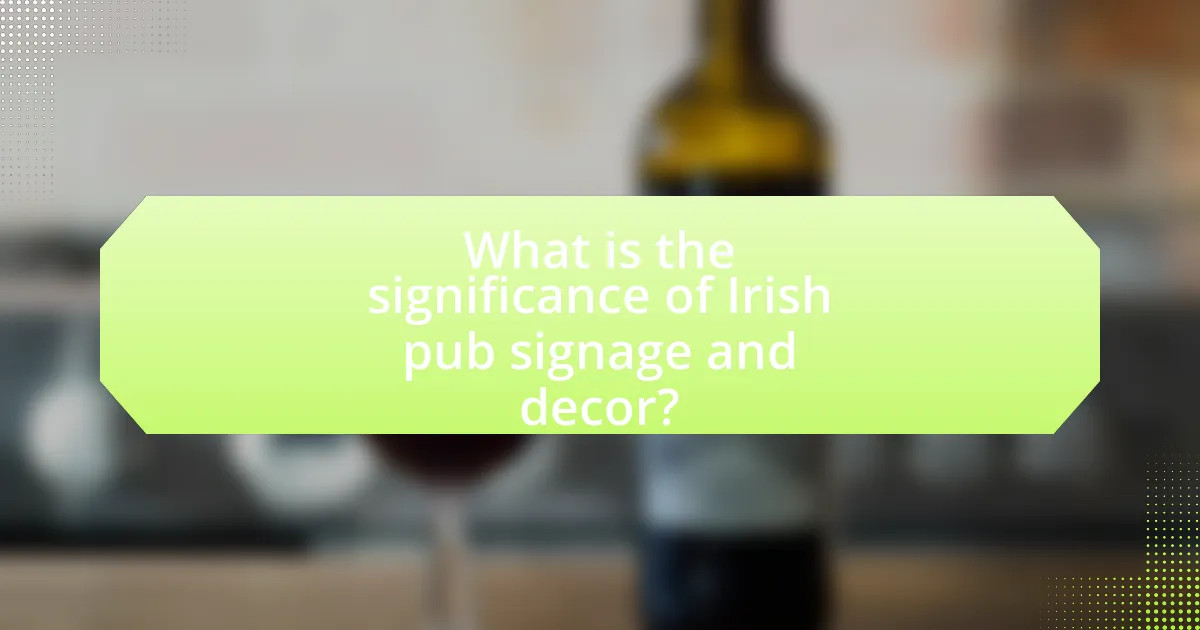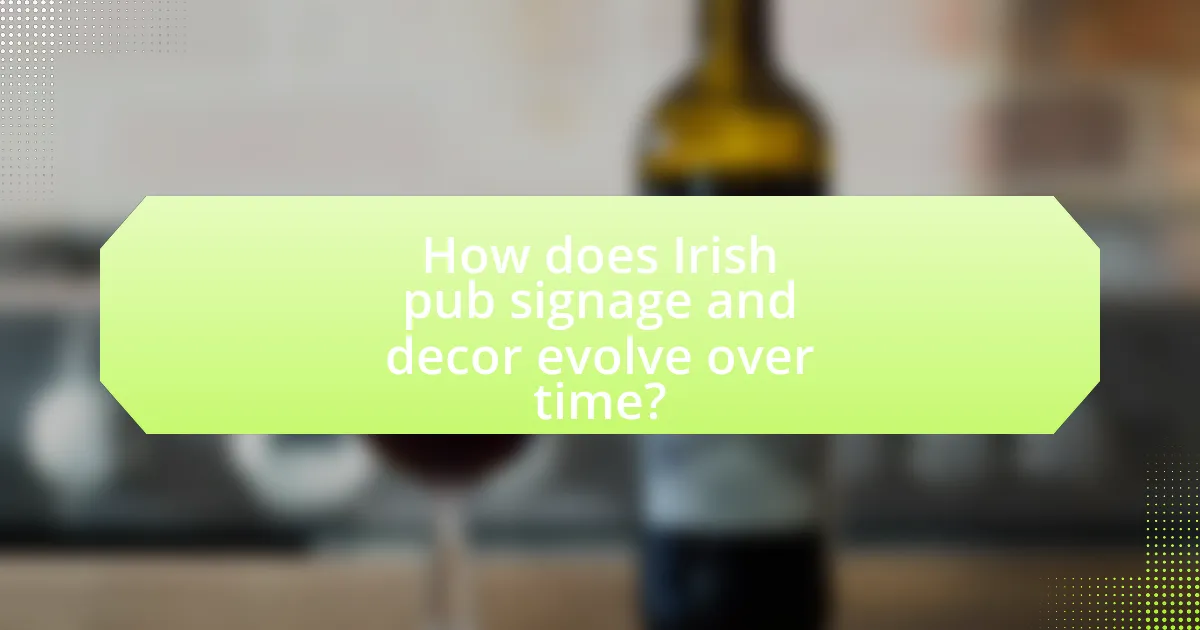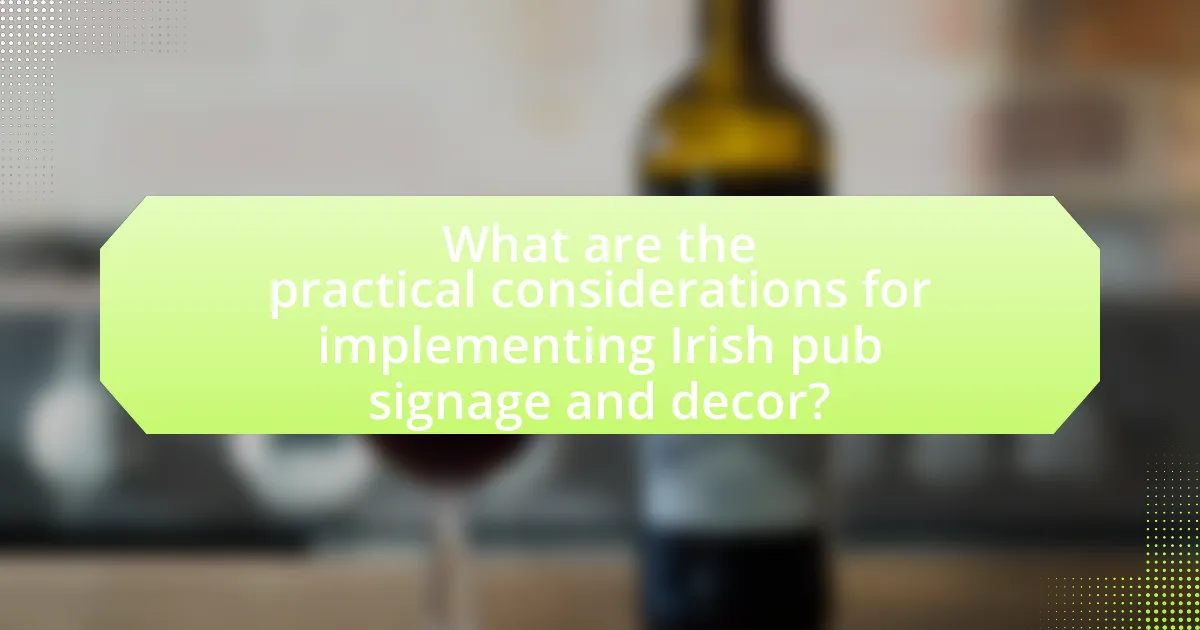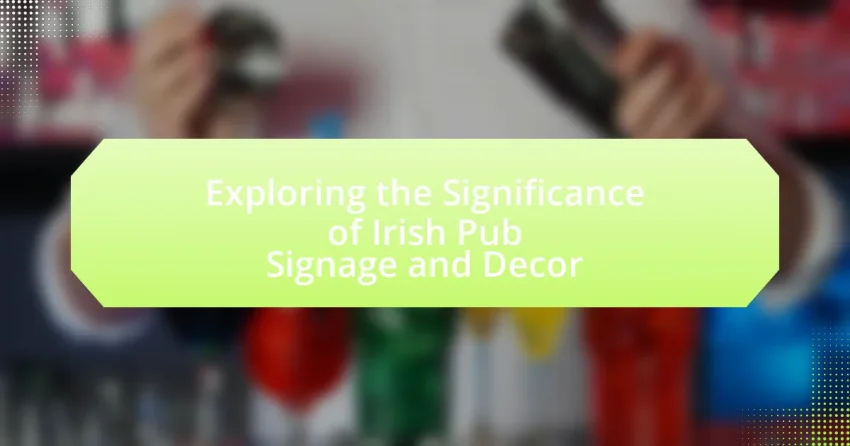The article explores the significance of Irish pub signage and decor, highlighting their role in reflecting cultural identity, heritage, and community values. It examines how traditional symbols, Gaelic language, and craftsmanship in signage preserve Irish culture while fostering a sense of belonging among patrons. The discussion includes the impact of colors and materials on cultural representation, the importance of decor in creating an inviting atmosphere, and the influence of regional differences on pub aesthetics. Additionally, the article addresses practical considerations for implementing effective signage and decor, including compliance with local regulations and budget considerations, ultimately emphasizing the role of storytelling and maintenance in enhancing the pub experience.

What is the significance of Irish pub signage and decor?
Irish pub signage and decor are significant as they reflect cultural identity, heritage, and community values. The vibrant colors, traditional symbols, and unique typography used in signage often evoke a sense of nostalgia and connection to Irish history. For instance, many pubs display Gaelic phrases or imagery related to Irish folklore, which reinforces cultural pride and continuity. Additionally, the decor, including vintage photographs and local artifacts, creates an inviting atmosphere that fosters social interaction and a sense of belonging among patrons. This combination of visual elements not only attracts customers but also serves as a storytelling medium that preserves and promotes Irish culture.
How do Irish pub signs reflect cultural heritage?
Irish pub signs reflect cultural heritage by showcasing traditional Irish symbols, language, and craftsmanship. These signs often feature Gaelic inscriptions, which preserve the Irish language and promote cultural identity. Additionally, many signs incorporate imagery such as shamrocks, harps, and Celtic knots, which are emblematic of Ireland’s history and folklore. The craftsmanship involved in creating these signs often employs local artisans, further connecting the pub to its community and heritage. This combination of language, symbolism, and artistry in pub signage serves as a visual representation of Ireland’s rich cultural narrative.
What symbols and imagery are commonly used in Irish pub signage?
Irish pub signage commonly features symbols and imagery such as shamrocks, harps, and Celtic knots. Shamrocks represent Irish heritage and good luck, while harps symbolize Ireland’s national identity and musical tradition. Celtic knots often signify the interconnectedness of life and eternity, reflecting the rich cultural history of Ireland. These elements are not only decorative but also serve to evoke a sense of place and community, reinforcing the pub’s role as a social hub in Irish culture.
How do colors and materials contribute to the cultural representation?
Colors and materials significantly contribute to cultural representation by embodying the values, traditions, and identity of a community. In the context of Irish pub signage and decor, specific colors like green symbolize Ireland’s lush landscapes and national identity, while materials such as wood reflect traditional craftsmanship and the historical significance of pubs as social gathering places. For instance, the use of reclaimed wood in pub interiors not only enhances authenticity but also connects patrons to the heritage of Irish hospitality. This alignment of colors and materials with cultural symbols fosters a sense of belonging and continuity within the community, reinforcing the pub’s role as a cultural hub.
Why is decor important in creating the atmosphere of an Irish pub?
Decor is crucial in creating the atmosphere of an Irish pub because it reflects the cultural heritage and social traditions associated with Irish hospitality. The use of traditional elements such as dark wood furnishings, vintage signage, and cozy lighting fosters a warm and inviting environment that encourages social interaction. Studies show that the ambiance created by decor can significantly influence patrons’ emotional responses and their overall experience, making them feel connected to the Irish culture. For instance, the presence of authentic Irish artifacts and memorabilia can evoke nostalgia and a sense of belonging, enhancing the communal spirit that is central to the Irish pub experience.
What elements of decor are essential for an authentic Irish pub experience?
Essential elements of decor for an authentic Irish pub experience include dark wood furnishings, traditional Irish artwork, and cozy lighting. Dark wood, often used in bar tops and furniture, creates a warm and inviting atmosphere typical of Irish pubs. Traditional Irish artwork, such as landscapes and historical pieces, reflects the cultural heritage and adds character to the space. Cozy lighting, often achieved through pendant lamps and candles, enhances the intimate ambiance that patrons expect in an Irish pub. These decor elements collectively contribute to the authenticity and charm of the Irish pub experience.
How does decor influence customer perception and engagement?
Decor significantly influences customer perception and engagement by creating an atmosphere that aligns with the brand identity and enhances the overall experience. For instance, in Irish pubs, traditional decor elements such as wooden furnishings, vintage signage, and cultural artifacts evoke a sense of authenticity and nostalgia, which can lead to increased customer satisfaction and loyalty. Research indicates that 60% of consumers make purchasing decisions based on the ambiance of a venue, highlighting the importance of decor in shaping perceptions and driving engagement.
What role does signage play in the branding of Irish pubs?
Signage plays a crucial role in the branding of Irish pubs by establishing a distinct identity and attracting customers. The visual elements of signage, such as traditional Irish symbols and typography, create an immediate association with Irish culture, enhancing the pub’s authenticity. For instance, the use of Gaelic language in signage can evoke a sense of heritage and community, appealing to both locals and tourists. Additionally, well-designed signage can improve visibility and recognition, contributing to brand loyalty. Research indicates that effective signage can increase foot traffic by up to 50%, demonstrating its impact on customer engagement and overall business success.
How can effective signage attract customers to an Irish pub?
Effective signage can attract customers to an Irish pub by clearly communicating the pub’s identity, offerings, and ambiance. Well-designed signs featuring traditional Irish elements, such as Celtic patterns or Gaelic language, create an inviting atmosphere that resonates with potential patrons. Research indicates that visually appealing signage can increase foot traffic by up to 20%, as it captures attention and conveys a sense of authenticity. Additionally, signs that highlight special promotions or events can entice customers to enter, further enhancing the pub’s visibility and appeal in a competitive market.
What are the best practices for designing pub signage?
The best practices for designing pub signage include ensuring clarity, using appropriate materials, and incorporating branding elements. Clarity is essential; signage should be easily readable from a distance, utilizing large fonts and contrasting colors to enhance visibility. Appropriate materials, such as weather-resistant options for outdoor signs, ensure durability and longevity, which is crucial for maintaining a professional appearance. Incorporating branding elements, like logos and color schemes that reflect the pub’s identity, helps create a cohesive look that attracts customers and reinforces brand recognition. Research indicates that well-designed signage can increase foot traffic by up to 50%, highlighting its importance in the competitive hospitality industry.

How does Irish pub signage and decor evolve over time?
Irish pub signage and decor evolve over time through a combination of cultural influences, technological advancements, and changing consumer preferences. Historically, traditional Irish pubs featured hand-painted wooden signs and rustic decor that reflected local heritage and craftsmanship. As globalization increased, modern Irish pubs began incorporating contemporary design elements, such as neon signs and minimalist aesthetics, to attract a broader audience. Additionally, the rise of digital technology has led to the use of electronic signage and interactive decor, enhancing customer engagement. This evolution reflects the dynamic nature of Irish culture and the need for pubs to remain relevant in a competitive market.
What historical influences have shaped Irish pub signage and decor?
Irish pub signage and decor have been shaped by a combination of cultural, religious, and economic influences throughout history. The Gaelic language, prevalent in Ireland, has contributed to the use of traditional Irish phrases and symbols in signage, reflecting national identity and heritage. Additionally, the influence of the Catholic Church is evident in the use of religious iconography and motifs, which often appear in pub decor, emphasizing community and social gatherings. Economic factors, particularly during the 19th century, led to the rise of commercial signage as pubs sought to attract patrons, resulting in the colorful and artistic designs that characterize many Irish pubs today. The combination of these historical influences has created a unique and recognizable aesthetic that is integral to the Irish pub experience.
How have modern trends impacted traditional Irish pub aesthetics?
Modern trends have significantly altered traditional Irish pub aesthetics by introducing contemporary design elements and technology. Traditional Irish pubs, characterized by dark wood, cozy atmospheres, and vintage decor, now often incorporate open layouts, minimalist furnishings, and modern lighting to appeal to a broader audience. This shift is evidenced by the rise of craft beer culture and the integration of digital menus and social media marketing, which have transformed the way pubs present themselves and engage with patrons. As a result, while some pubs maintain classic elements, many have adapted their aesthetics to reflect current consumer preferences, blending the old with the new to create a hybrid experience.
What role does tourism play in the evolution of pub decor?
Tourism significantly influences the evolution of pub decor by driving the demand for unique and culturally resonant experiences. As visitors seek authentic local atmospheres, pubs adapt their interiors to reflect regional heritage, often incorporating traditional Irish elements such as vintage signage, rustic furnishings, and local artwork. This adaptation not only enhances the aesthetic appeal but also creates a sense of place that resonates with tourists, thereby increasing patronage. For instance, the rise of themed pubs in tourist-heavy areas showcases how decor evolves to cater to the expectations of visitors, blending modern trends with historical references to attract a diverse clientele.
How do regional differences affect Irish pub signage and decor?
Regional differences significantly influence Irish pub signage and decor by reflecting local culture, history, and community identity. For instance, pubs in urban areas like Dublin often feature modern designs and vibrant signage to attract a diverse clientele, while rural pubs may showcase traditional elements, such as hand-painted signs and rustic decor, emphasizing local heritage. Additionally, specific regions may incorporate symbols or colors associated with local sports teams or historical events, further personalizing the pub’s atmosphere. This regional variation not only enhances the aesthetic appeal but also fosters a sense of belonging among patrons, making the pub a central part of community life.
What variations exist between urban and rural Irish pubs?
Urban and rural Irish pubs differ significantly in atmosphere, clientele, and decor. Urban pubs tend to have a modern, vibrant atmosphere with contemporary decor, catering to a diverse crowd, including tourists and young professionals. In contrast, rural pubs often feature traditional decor, such as wooden beams and local memorabilia, fostering a cozy, community-oriented environment that attracts locals. This distinction is supported by the fact that urban pubs frequently host live music and events to draw in crowds, while rural pubs may focus more on socializing and local culture, reflecting the slower pace of life in the countryside.
How do local customs influence the design of pub signage?
Local customs significantly influence the design of pub signage by reflecting cultural values, historical references, and community identity. For instance, in Ireland, pub signage often incorporates Gaelic language, traditional symbols, and local folklore, which resonate with the community’s heritage. This practice not only attracts patrons but also fosters a sense of belonging and pride among locals. Additionally, specific customs, such as the use of particular colors or motifs associated with regional festivals, further tailor the signage to the local context, enhancing its relevance and appeal.

What are the practical considerations for implementing Irish pub signage and decor?
Practical considerations for implementing Irish pub signage and decor include ensuring authenticity, compliance with local regulations, and creating an inviting atmosphere. Authenticity is crucial as it reflects the cultural heritage of Ireland, which can be achieved through traditional colors, fonts, and imagery that resonate with Irish identity. Compliance with local regulations involves adhering to signage laws, including size, placement, and illumination, to avoid legal issues. Creating an inviting atmosphere requires thoughtful placement of decor elements to enhance the overall ambiance, encouraging customer engagement and comfort. These considerations are essential for establishing a successful Irish pub that attracts patrons and fosters a genuine experience.
How can pub owners effectively choose signage and decor elements?
Pub owners can effectively choose signage and decor elements by aligning them with their brand identity and target audience preferences. This alignment ensures that the signage and decor resonate with customers, enhancing their overall experience. For instance, research indicates that establishments with cohesive branding see a 20% increase in customer retention, as consistent visuals create familiarity and trust. Additionally, incorporating local cultural elements can attract community support and interest, as seen in pubs that feature regional artwork or historical references, which often lead to increased foot traffic and customer engagement.
What budget considerations should be taken into account for signage and decor?
Budget considerations for signage and decor include material costs, design expenses, installation fees, and maintenance requirements. Material costs vary significantly based on the type of signage, such as wood, metal, or digital displays, with wood typically costing between $20 to $100 per square foot, while digital signage can exceed $1,000. Design expenses may involve hiring a graphic designer, which can range from $50 to $150 per hour, depending on expertise. Installation fees should also be factored in, as professional installation can add 10% to 20% to the total cost. Lastly, ongoing maintenance costs, including repairs and updates, should be anticipated, as they can represent an additional 5% to 10% of the initial investment annually.
How can pub owners ensure compliance with local regulations regarding signage?
Pub owners can ensure compliance with local regulations regarding signage by thoroughly researching and understanding the specific laws and guidelines set by their local government. This includes reviewing zoning laws, obtaining necessary permits, and adhering to size, placement, and content restrictions outlined in municipal codes. For instance, many municipalities have specific regulations that dictate the dimensions and illumination of signs, which can be found in local planning documents or by consulting with local authorities. Additionally, engaging with a legal expert or a signage consultant can provide clarity on compliance requirements, ensuring that all signage meets legal standards and avoids potential fines or removal.
What tips can enhance the effectiveness of Irish pub signage and decor?
To enhance the effectiveness of Irish pub signage and decor, utilize authentic Irish themes and colors that resonate with cultural heritage. Incorporating traditional elements such as Gaelic fonts, Celtic patterns, and imagery of iconic Irish symbols like shamrocks or harps can create a strong cultural connection. Research indicates that establishments that reflect local culture through decor see a 20% increase in customer engagement, as patrons feel a deeper connection to the environment. Additionally, ensuring that signage is clear, well-lit, and strategically placed can improve visibility and attract foot traffic, which is crucial for maximizing patronage.
How can storytelling be integrated into pub signage and decor?
Storytelling can be integrated into pub signage and decor by using visual narratives, historical references, and thematic elements that reflect the pub’s identity and culture. For instance, murals depicting local legends or historical events can create a sense of place and connection for patrons. Additionally, signage that includes anecdotes or quotes related to the pub’s history or the community can engage customers and enhance their experience. Research indicates that establishments that incorporate storytelling into their decor see increased customer engagement and satisfaction, as it fosters a deeper emotional connection to the space.
What maintenance practices are essential for preserving pub signage and decor?
Essential maintenance practices for preserving pub signage and decor include regular cleaning, protective coatings, and timely repairs. Regular cleaning prevents dirt and grime buildup, which can degrade materials over time. Protective coatings, such as varnishes or sealants, shield surfaces from weather elements and UV damage, extending their lifespan. Timely repairs address any damage promptly, preventing further deterioration. These practices are supported by industry standards that emphasize the importance of maintenance in preserving the aesthetic and functional qualities of signage and decor in hospitality settings.
